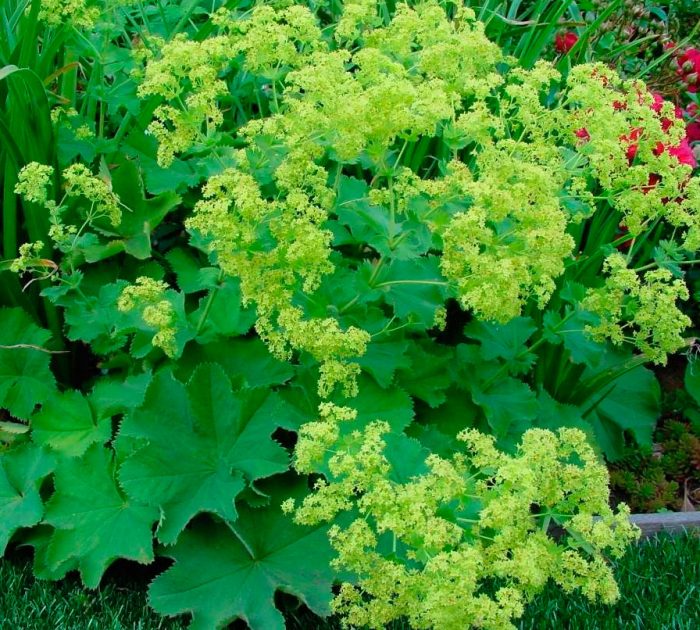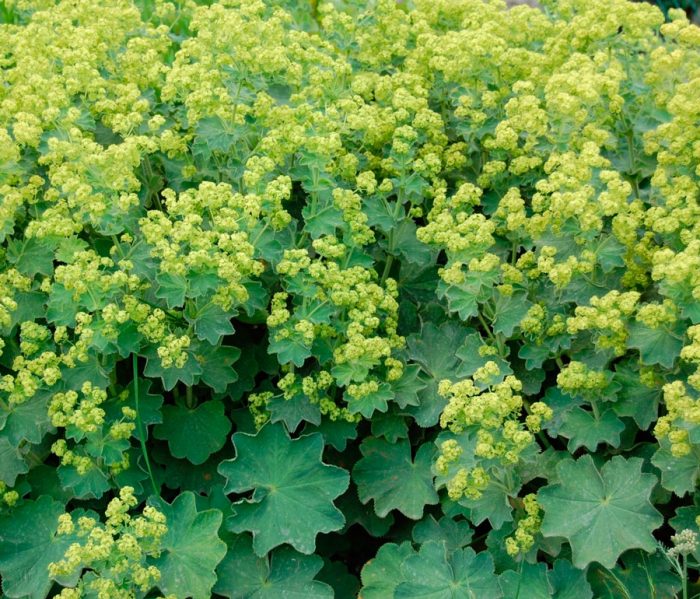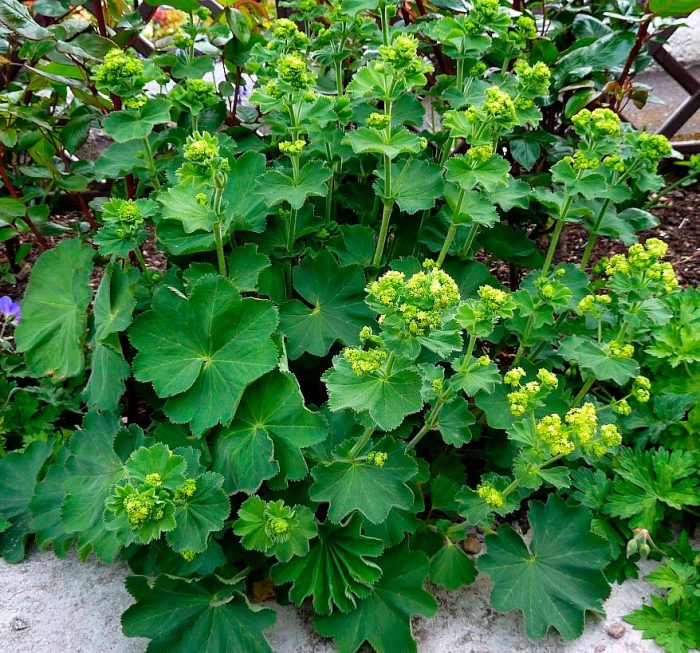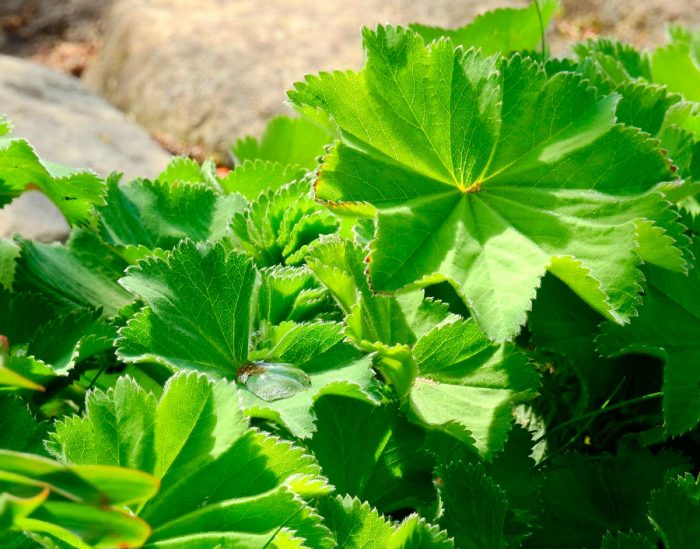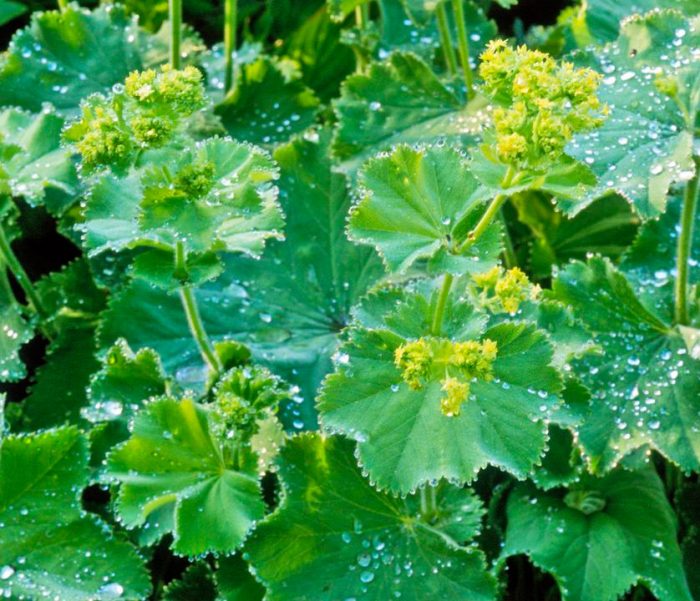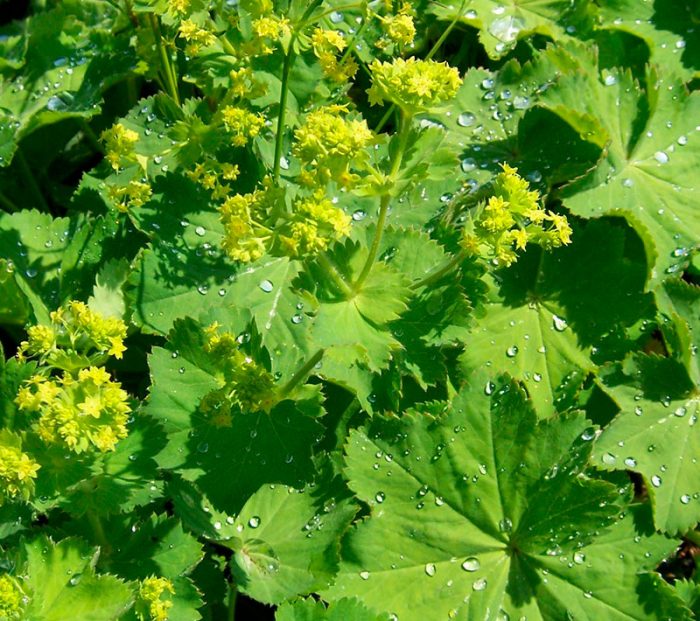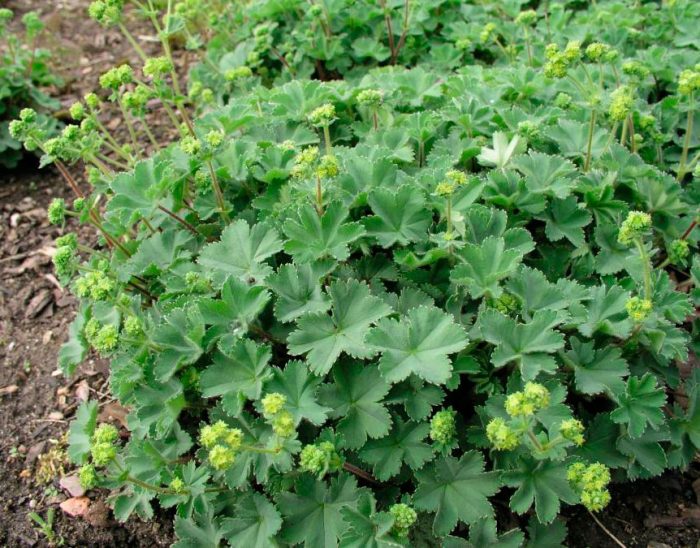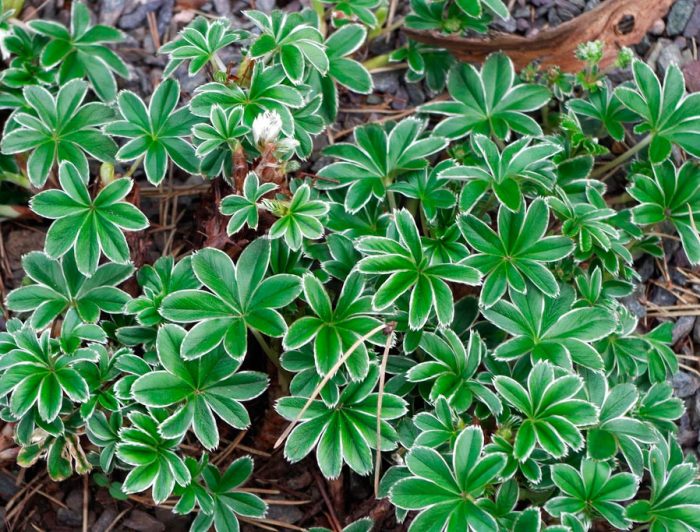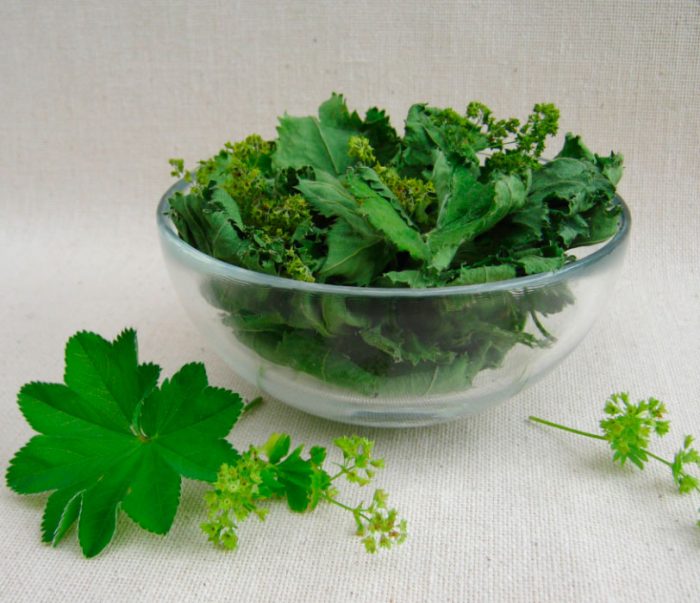Such a herbaceous perennial as a cuff is often used by gardeners to create a relief green cover in a flower garden and in an area where shrubs grow. This plant is part of the Pink family. The cuff is most widespread in nature in Eurasia, North and South America; it is somewhat less common in New Zealand and Africa. This plant is distinguished by its high decorative effect, and it also has medicinal properties. It is popularly called a sickness, a ram, a goose foot, breast grass, bear's paw, God’s tear, or inter-finger.
Content
Features of the cuff
The cuff is a herbaceous perennial plant whose surface rhizome is creeping. In length, the shoots reach about half a meter, they can have dense pubescence or be naked. Shoots grow from growing points and can both creep along the surface of the soil and rise above it.
Near the base of the stem are the largest carved leaf plates, their petioles are very dense. Smaller leaves are formed from internodes. The foliage is finger-shaped, rounded, divided into segments with varying degrees of dissection, and its surface is decorated with relief radial veins. Each leaf plate has from 7 to 11 blades, which are colored greenish yellow or deep green. Sometimes there is a slight dissection of the sheet plate, in this case it has an almost round shape. It can also be cut very strongly or be folded. The foliage has a finely toothed edge. The foliage has a short dense pubescence, because of this, dew drops do not fall directly on the surface of the leaves and do not roll down to the ground, but gather together, forming sparkling pearls.
Bloom is observed from June to September. At this time, straight tall peduncles grow from internodes, on which small umbrella-shaped inflorescences are formed, they include small nondescript flowers of a greenish-yellow hue. But the plus of these flowers is that they have a pleasant honey smell.In place of the pollinated flowers, over time, small oblong fruits are formed, which are outwardly similar to nuts. They have a large number of small seeds ripening inside them.
Reproduction methods
For reproduction of the cuff, generative (seed) and vegetative methods are used.
Growing from seeds
From seeds, the cuff is grown through seedlings. To do this, a fertile loose soil mixture is poured into the box, which passes air and water well. At the same time, it is recommended to make a drainage layer of expanded clay or pebbles at the bottom of the container. Seeds are sown to a depth of 0.7 to 1 cm. Sowing is carried out in March or November. If sowing was carried out in the fall, then 15 days after sowing the seeds, the box is transferred to the street. It is placed in a place that has reliable protection from direct sunlight and drafts.
In springtime, transfer crops to a well-lit and warm place. Since during the winter the seeds have undergone natural stratification, seedlings appear relatively quickly. After they have formed from 2 to 4 true leaf plates, they should be cut into individual peat pots. Cuff seedlings are planted in open ground in the spring after warm weather is established (sometimes this happens already in the last days of April). The bushes will delight you with their flowering in the first year of growth.
Reproduction by dividing the bush
A heavily overgrown bush can be divided into several parts. Often, lodging shoots themselves give rise to roots. The shoots that have their own root system, if necessary, can be cut off from the mother bush using a sharp tool. Lift the scion out of the soil and plant it in its permanent location. When planting bushes, the distance between them should be at least 0.3 m. It is best to propagate the cuff in this way in early spring.
Planting and care in the open field
Choosing a landing site
For planting the cuff, it is recommended to choose an open sunny area, a place in a little shade is also suitable. It is not recommended to plant it under trees with a lush dense crown, in this case the flower will grow poorly and be sick relatively often. The soil should be light, saturated with humus, and also allow air and water to pass through well. Loamy or sandy loam soil, which can be slightly acidic or neutral, is best suited.
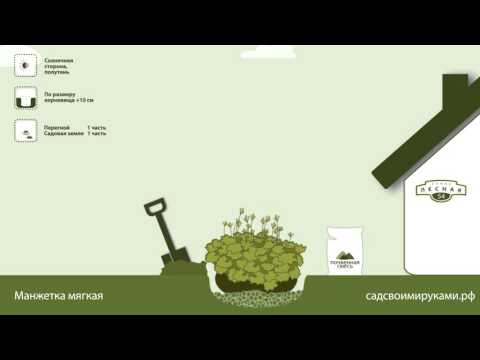

Watch this video on YouTube
Cuff care
Water the cuff frequently and abundantly. Do not allow liquid to stagnate in the ground, because this can cause fungal disease to attack the root system. If desired, from time to time you can loosen the soil surface near the bushes.
Such a plant is able to suppress the growth of weeds, which greatly facilitates its care. Experts advise, feeding twice or thrice during the season. Best of all, the cuff responds to the introduction of organic matter, for this they most often use an infusion of chicken droppings or mullein, and also fermented infusion of weeds.
Pruning
Such a fast growing plant needs systematic pruning. This will keep the cuff from growing. And thanks to the timely pruning of wilted inflorescences, self-seeding will be avoided. One bush in the same place can be grown for several decades, and at the same time it will retain its decorative effect.
Wintering
This garden culture is highly resistant to frost. Moreover, it winters well in the open field, even in mid-latitudes. If the frosts are very strong in winter, then sprinkle the bushes with loose leaves in the autumn. With the onset of spring, the bushes are cleaned and pruned for sanitary purposes, removing all those shoots that have dried up or have been injured.Remember that this plant is fast growing, so you should not be afraid to shorten its shoots.
Diseases and pests
If you care for the cuff correctly and choose a suitable area for it, then it will practically not hurt. Powdery mildew is observed when grown on wet, heavy soil. Bushes that grow in the shade are affected by black rust.
Most often, the plant suffers from slugs and snails. To prevent gastropods from reaching the cuff, sprinkle the surface of the ground around the bushes with crushed egg shells or wood ash.
Types of cuffs with photos and names
There are about 600 different types of cuffs in nature. Often, different species look exactly the same, and only a specialist will be able to distinguish between them. On the garden plot, those species are most often cultivated that are described in detail below.
Common cuff (Alchemilla vulgaris)
This species has medicinal properties and is widely used in medicine. On the surface of its rising green stems, pubescence is found. Folded, rounded leaf plates have from 7 to 10 radial veins. Flowering begins in the last days of May and is not abundant. False-umbellate inflorescences consist of very small pale green or yellowish flowers. Since the rhizome of a plant is creeping, it can grow rapidly, capturing more and more new territories. Some gardeners consider this type of cuff a weed, because it is distinguished by its vitality and is almost impossible to eradicate.
Soft cuff (Alchemilla mollis)
In this species, sprawling spherical bushes are formed, and all due to the fact that its branched shoots are erect, and in height they reach from 0.45 to 0.5 m.The rich green lobed leaf plates of a round shape have a dense short pubescence. They are divided into 9-11 concave sectors. Bushes bloom from June to August. At this time, a large number of tall inflorescences are formed, consisting of yellowish-green flowers, reaching about 0.3 cm in diameter. The seed material fully ripens in the first days of September.
Red cuff (Alchemilla erythropoda)
Such a ground cover perennial reaches a height of no more than 15 centimeters. The seamy surface of the leaf plates, as well as their petioles, have a pale red tint. Rounded leaves are divided into 7-9 sectors, and they are painted in a greenish-blue hue. In June or July, panicles open on the bushes, which include yellowish flowers, reaching about 1 cm in diameter.
Cuff connected (Alchemilla conjuncta)
Rising branched stems reach no more than 20 centimeters in height. The shoots are decorated with rounded leaf plates deeply dissected into seven lobes, the surface of which is glossy, smooth, rich green color. The seamy surface has a dense pubescence of a silvery color. Flowering begins in July. The color of the flowers is yellowish green.
Cuff in landscape design
The cuff is very popular among landscape designers due to its openwork sheet plates. It allows you to create a green cover in the garden. Most often, for planting such a plant, they choose the sides of garden paths, slopes, or an area located near the stony masonry. For framing flower beds, low-growing varieties of cuffs are used. Thanks to its rich foliage, flowering crops look more impressive.
The yellow-green flowers of such a perennial are distinguished by their peculiar beauty and can also become a decoration for your garden, like its foliage. Experts recommend planting the cuff next to a delphinium, daylily, thyme or astilba.
Healing properties
The fact that the cuff has healing properties became known to man for a long time.Moreover, it has found wide application both in folk and official medicine in a large number of countries.
Raw materials are harvested at a time when the bushes are blooming, immediately after the morning dew has dried on the foliage. Cut off the entire aerial part of the plant, after which it is removed for drying. To do this, choose a place in the fresh air that has reliable protection from rain and from direct sunlight. A completely dried cuff is stored in a glass jar or in a paper bag. Shelf life is 1 year.
The cuff contains many useful substances, for example: ascorbic acid, flavonoids, coumarins, resins, steroids, tannins, phenolcarboxylic and fatty acids, lipids, catechins, and also trace elements (iron, copper, boron, nickel, zinc, manganese and molybdenum ).
Infusions, decoctions and compresses are distinguished by the following useful properties: lactogenic, anti-inflammatory, antimicrobial, hemostatic, wound-healing, vaso-strengthening and antitumor. This plant is widely used in gynecology. The phytohormones included in its composition help to cure female infertility, restore the menstrual cycle and maintain pregnancy. But self-administration of cuff-based drugs is unacceptable. They are taken only under medical supervision.
Tea made from this plant helps to improve the condition of type 2 diabetes. It improves the functioning of the intestines and pancreas by normalizing the amount of sugar in the blood.
Reception of funds based on the cuff is possible at any age, regardless of the state of health. It is forbidden to take them only in case of violation of intestinal motility and with individual intolerance.


Watch this video on YouTube

